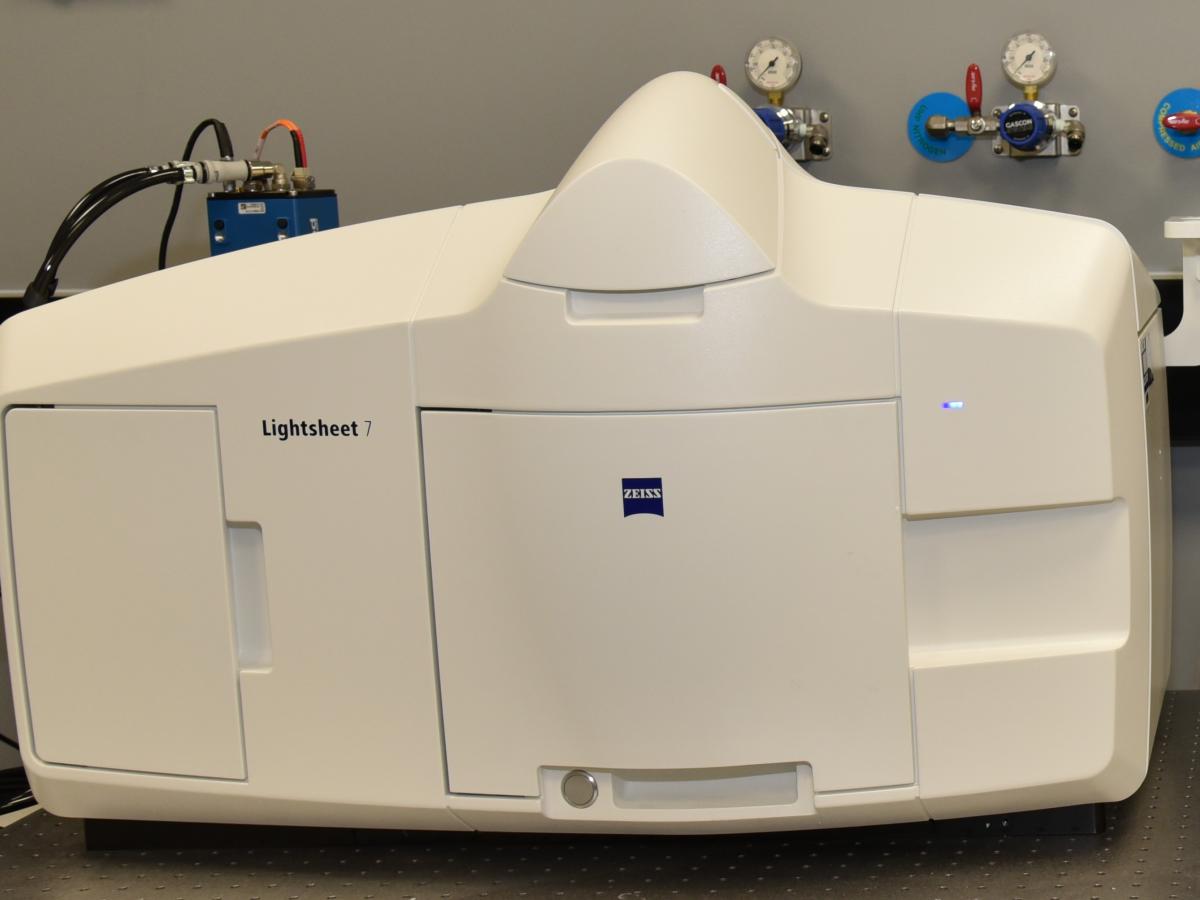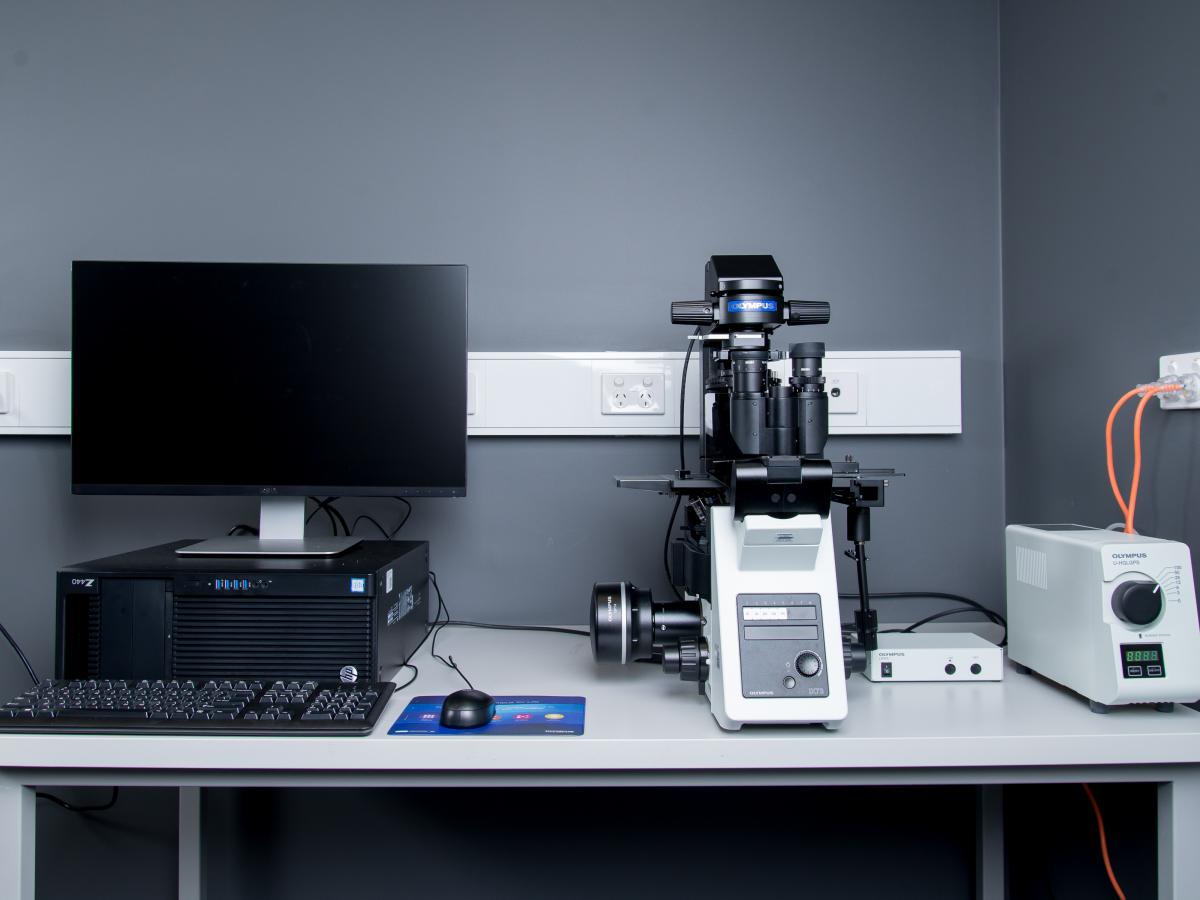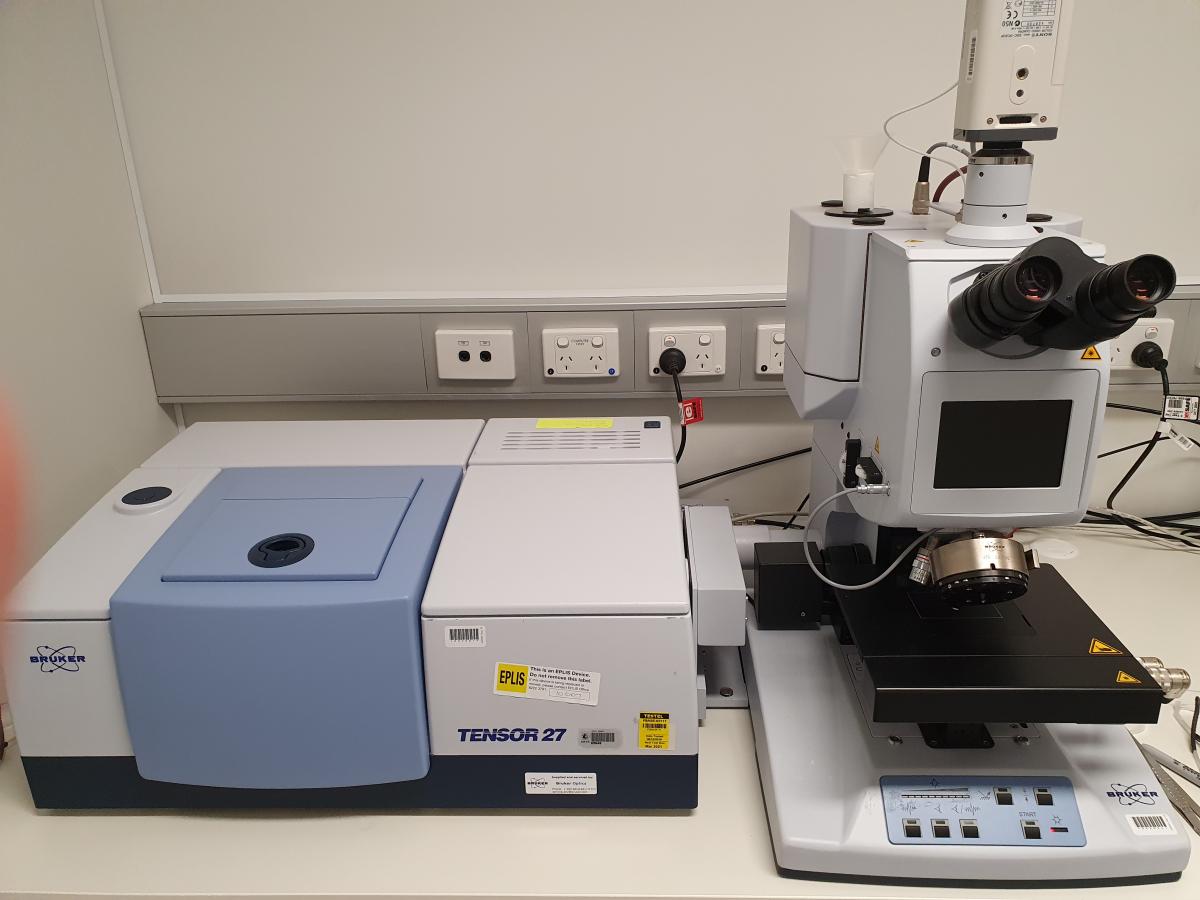Optical Microscopes

Zeiss Lightsheet 7
Please contact Dr Jane Sibbons for further information.
Located at the Bioimaging Facility in the Molecular Life Sciences Building.
-
Information on the Lightsheet 7
Lightsheet microscopy, also known as selective plane illumination microscopy (SPIM), is an advanced imaging technique used in biological research to visualise and study biological samples with high resolution and minimal photo damage. It provides a non-invasive way to capture three-dimensional (3D) images of living organisms, tissues, and cellular structures.
The fundamental principle of lightsheet microscopy involves illuminating the sample with a thin sheet of laser light and imaging it from the perpendicular direction. By using a thin sheet of light to illuminate the sample, lightsheet microscopy minimises the amount of light that passes through regions of the sample that are not currently being imaged. This reduces phototoxicity and photobleaching, which can adversely affect the viability of living samples and the quality of the acquired images.
The Lightsheet 7 has the flexibility to image both fixed optically cleared samples and living model organisms, tissues and cells as they develop over time. Specimens up to 2 cm in size, at any refractive index between 1.33 and 1.56 can be imaged. This stable turnkey light sheet microscope lets researchers acquire overview images and data with subcellular resolution.
Features
Objectives:
Detection objectives
Objective lens
NA
Immersion
Working distance
5x
0.16
Water immersion WD= 5.1mm
5.1mm
0.16
Clearing immersion nd+1.33-1.58 WD 10.5mm
10.5mm
10x
0.5
Water immersion WD= 3.5mm
3.5mm
20x
1.0
Water immersion
2.4mm
1.0
Clearing Corr nd=1.45
5.6mm
1.0
Clearing Corr nd=1.53
6.4mm
Illumination objectives
- Lightsheet 7 Illumination optics 5x/0.1 foc
- Lightsheet 7 Illumination optics 10x/0.2 foc
Chamber:
Chamber water
Chamber water
Chamber large Clr
Chamber 20x Clr
Objective lens/magnification
5x air
20x dipping
5x air
20x dipping
Free working distance
6.1 mm
2.4 mm
10 mm
5.1 mm
Max sample size that can be imaged in toto with rotation
(X x Y x Z --- W x Lx D)
10 x 22 x 10mm
10 x 22 x 4.8 mm
14 x 30 x 14 mm
10 x 30 x 10 mm
Max sample size that can be imaged in toto with rotation
(X x Y x Z --- W x Lx D)
10 x 22 x 6.1mm
10 x 22 x 2.4 mm
10 x 30 x 10 mm
10 x 30 x 5.1 mm
Camera:
- 2x PCO Edge 4.2 with QE 83%, 1920 x 1920 px, 57 fps (at 1k x 1k)
Environmental controls:
- O2 regulator
- CO2 regulator
- Temperature
Solid state lasers:
405 nm (50mW), 445nm (25mW), 488 nm (50mW), 515 nm (20mW), 561 nm (50mW), 638 nm (75mW)

Olympus BX51 - Research Grade Optical Microscope DIC, Phase, DF, BF
Please contact Dr Jane Sibbons for further information.
Located at the Bioimaging Facility in the Molecular Life Sciences Building.
-
Information on the Olympus BX51 - Research Grade Optical Microscope DIC, Phase, DF, BF
The Olympus BX51 upright optical microscope at Adelaide Microscopy features 4X, 10X, 20X, 40X, 63X (oil) and 100X (oil) lenses. The capabilities of the BX51 include Nomarski differential interference contrast (DIC), fluorescence, dark-field and polarization microscopy
Five long-pass filters are available for fluorescence microscopy. These filters and examples of the fluorophores for which they can be used are:
- Ultra-violet (UV): DAPI
- Blue-violet (BV): Lucifer yellow
- Intermediate blue (IB): GFP, EGFP, FITC, Alexa 488
- Intermediate green (IG): CY3, DS red, TRITC, RITC
- CY5: CY5
The microscope is fitted with Soft Imaging System’s Colorview III camera and AnalySIS Life Sciences software. The Colorview III camera can record 24-bit colour images at resolutions up to 2576 X 1932 pixels and 16-bit monochrome images at resolutions up to 1288 X 966 pixels. The AnalySIS software fully controls and configures the Colorview III camera and has features that simplify the recording of images. These features include a system for sequentially recording fluorescence images from different fluorophores without the need to adjust exposure times thereby reducing the time to record the images and minimising photo-bleaching. The AnalySIS software can be used to perform complex image analysis on captured images and is fully compatible with the other AnalySIS systems at Adelaide Microscopy.

Nikon Eclipse LV100 POL Petrographic Microscope
Please contact Dr Ben Wade for further information.
Located at Frome Road.
-
Information on the Nikon Eclipse LV100 POL Petrographic Microscope
Needs further information.

Nikon Ti E Live Cell Microscope
Please contact Dr Jane Sibbons for further information.
Located at the Bioimaging Facility in the Molecular Life Sciences Building.
-
Information on the Nikon Ti E Live Cell Microscope
Maintaining the biological conditions of cells (at 37C, 5% CO2 and humidified), while on the microscope stage will ensure that they behave naturally and is crucial during live cell imaging experiments.
Many cellular processes can be visualized directly using the Nikon Ti E Live Cell Microscope. Some of these in vitro assays, like chemotaxis, or tube formation assays, don't even require staining and can easily be performed with simple phase contrast techniques. However, fluorescence microscopy can reveal more structural details and molecular interaction by using reporter proteins like GFP. Other Live cell Imaging applications include: Growth / Replication, Chemotaxis, Angiogenesis, and Migration / Wound healing.
Featuring
Fully motorised inverted microscope, Photometrics camera, Lumencor fluorescence light source, Okolab cage incubation system with temperature, humidity and CO2 control and easy to use NIS elements software, this instrument is ideal for capturing high-quality phase contrast / DIC images, as well as bright fluorescence images of living cells over time.
Capabilities
- Up to 6D imaging
- X, Y, Z, λ, t, multipoint, large image stitching
- Long term live cell imaging >72hrs
- Perfect focus system (PFS) to keep cells in focus
- Programmable incubation conditions
- 3 C above ambient to 40 C
- 0% - 18% CO2
- Multiple analysis functions within NIS Elements software include:
- Object counting
- Measurements and annotations
- Object tracking
- Co-localisation
- Pixel classifier
- Time measurement
- ROI statistics
- Up to 6D imaging

Nikon SMZ25 stereo microscope with fluorescence and CCD camera
Please contact Dr Gwen Mayo for further information.
Located at Waite facility.
-
Information on the Nikon SMZ25 stereo microscope with fluorescence and CCD camera
The Nikon SMZ25 is a research grade stereo microscope with fluorescence, equipped with DS-Ri1 colour cooled digital camera for high resolution widefield imaging.
The SMZ25 has a world first zoom ratio of 25:1 (zoom range 0.63x - 15.75x). Nikon’s Perfect Zoom System dynamically alters the distance between the two optical axes as the zoom factor varies, maximizing light entry at every magnification and high resolution in both eye-paths, and minimal aberrations over the entire zoom range. Combining these innovative optics with high NA 2x objective and a fly-eye lens, clear fluorescent images with improved signal to noise ratios are possible even in low excitation light applications.
The 0.5 x objective adds flexibility, with a wide field of view at low magnifications. Auto Link Zoom (ALZ) maintains the same field of view when switching between 0.5x and 2x objective lenses.
Fluorescence filters are GFP-B (ex 460-500, em 510–560), RFP (ex 530–560, em 590–650) and EYFP (ex 490–500, em 520-560).
The NIS-Elements AR-Duo control software platform incorporates visualization, image analysis, processing, and data management.
For more details visit the Nikon website.

Nikon SMZ25 stereo microscope with fluorescence and CMOS camera
Please contact Dr Jane Sibbons for further information. Located at the Bioimaging Facility in the Molecular Life Sciences Building.
-
Information on the Nikon SMZ25 stereo microscope with fluorescence and CMOS camera
The Nikon SMZ25 is a research grade stereo microscope with fluorescence, equipped with DS-Ri1 colour cooled digital camera for high resolution widefield imaging.
The SMZ25 has a world first zoom ratio of 25:1 (zoom range 0.63x - 15.75x). Nikon’s Perfect Zoom System dynamically alters the distance between the two optical axes as the zoom factor varies, maximizing light entry at every magnification and high resolution in both eye-paths, and minimal aberrations over the entire zoom range. Combining these innovative optics with high NA 2x objective and a fly-eye lens, clear fluorescent images with improved signal to noise ratios are possible even in low excitation light applications.
The 0.5 x objective adds flexibility, with a wide field of view at low magnifications. Auto Link Zoom (ALZ) maintains the same field of view when switching between 0.5x and 2x objective lenses.
Fluorescence filters are GFP-B (ex 460-500, em 510–560), RFP (ex 530–560, em 590–650) and EYFP (ex 490–500, em 520-560).
The NIS-Elements AR-Duo control software platform incorporates visualization, image analysis, processing, and data management.
For more details visit the Nikon website.

Nikon Ni-E optical microscope with fluorescence
Please contact Dr Gwen Mayo for further information.
Located at Waite facility.
-
Information on the Nikon Ni-E optical microscope with fluorescence
The Nikon Ni-E microscope is a research grade compound microscope with bright-field, differential interference contrast and wide-field fluorescence, and a DS-Ri1 colour cooled digital camera for high quality imaging.
A motorized stage allows for automated functions and multi-dimensional acquisition (time, XY, Z-series, lambda, image stitching).
The microscope has four dry objectives (4x, 10x, 20x, 40x), a 60x water immersion objective, and a 100x oil immersion objective.
The UV light source is a solid state Lumencor Sola. Fluorescence filters include DAPI (Ex 340-380, Em 435-485), GFP (Ex 455-485, Em 500-545), YFP (Ex 490-500, Em 520-560), CY3 (Ex 530-560, Em 573-648).
The NIS-Elements AR control software platform incorporates visualization, image analysis, processing and data management.

ThermoFisher Scientific ArrayScan XTI Live Cell High Content Platform
Please contact Dr Agatha Labrinidis for further information.
Located at Adelaide Health & Medical Sciences Building.
-
Information on the ThermoFisher Scientific ArrayScan XTI Live Cell High Content Platform
The Thermo Scientific ArrayScan XTI Live High Content Platform is a complete research solution for automated cellular imaging and analysis.
The ArrayScan XTI Live High Content Platform builds on more than a decade of R&D and utilizes optics from worldwide leaders in image capture. The versatile and intuitive Thermo Scientific HCS Studio Cell Analysis Software completes this instrument to facilitate automated, quantitative cellular and subcellular imaging and analysis.
The Thermo Fisher Arrayscan, is able to image many samples plated in high density format (any number well plate up to a 1536 well plate) with high quality high resolution lenses in both Live-Cell and Confocal mode. Automated algorithms then analyse the images to identify and quantify desired parameters such as individual cell or organelle morphology and spatial distribution of targets. Additionally, this instrument includes a series of specifically designed high content screening tools that report quantitatively on cellular targets and answer complex biological questions. This instrument is able to automatically identify pre-specified features and score parameters such as abundance, area, or many other desirable characteristics from confocal images in 3D.
FEATURES:
- High Level of Sensitivity—By harnessing the photon-collecting power of the Sony SuperHAD microlens architecture, the X1 camera becomes a highly sensitive camera with 4.5μm/pixel resolution.
- Imaging living cells—The Thermo Scientific Live Cell Module provides full control of temperature (ambient to 45°C), CO2 (0-10%) and added humidity (>90% RH) to the sample chamber to maintain cell health for experiments with living cells or tissues.
- Seven-colour, LED Solid-State Light Engine—The ArrayScan XTI Live High Content Platform's LED light engine reduces intensity fluctuations and optical component wear, eliminates moving parts, and reduces both integration and channel switching times, all while adding expanded fluorescence capabilities.
- Superior Optics—Axio Z1 Observer from Carl Zeiss, one of the leaders in optical technology, ensures optimal performance in image acquisition when used with the matched components on the platform.
- The Thermo Scientific ArrayScan Confocal and Objective Module enables the Thermo Scientific ArrayScan High Content Analysis (HCA) Readers to be operated in confocal mode while increasing optical resolution. Featuring the latest in high-speed Nipkow spinning disk technology and a variable pinhole, the ArrayScan Confocal and Objective Module enables finer control over image acquisition across a range of objectives (magnifications) in order to balance image quality and performance for the most demanding cell biology experiments; e.g., stem cell colonies, tissues, and 3D microenvironments.
CAPABILITIES
- Proprietary Thermo Scientific AccuFocus System is fast, yet flexible, for imaging cells, organelles, and low contrast targets.
- Unique intelligent acQuisition (iQ) real time analysis feedback to optimize image collection and data quality
- HCS Studio Cell Analysis Software is the integrated instrument control, visualization and analysis software package for novice to advanced users.
- Thermo Scientific Store Image and Database Management Software, Standard Edition, is used for managing the images and data automatically transferred from a Thermo Scientific High Content Product.

Oxford NanoImaging - Nanoimager (Super-resolution)
Please contact Dr Jane Sibbons for further information.
Located at the Bioimaging Facility in the Molecular Life Sciences Building.
-
Information on the Oxford NanoImaging - Nanoimager (Super-resolution)
The Nanoimager achieves super-resolution by single-molecule localization (dSTORM and PALM).
These techniques involve localizing only subsets of fluorophores in consecutive frames with high precision (typically better than 20 nm laterally and 50 nm axially), and reconstructing an image from the positions of the localizations.
The instrument supports various modes of operation: single-molecule localization-based super-resolution for quantitative cellular imaging, TIRF and epifluorescence for diffraction-limited fluorescence imaging, single-molecule FRET for measuring molecular interactions in the 2-10 nm range and single particle tracking PALM in cells.
APPLICATION
Tracking single molecules and vesicles in cells
- Quantitative cellular imaging
- Molecular mechanisms and interactions
- Protein complex assembly
- Epigenetic mapping
- DNA-PAINT shows sub-20nm resolution
- Single-molecule FRET
- Exosomes and microvesicles
- Neuronal imaging
FEATURES
Achievable resolution
- Lateral: exceeding 20 nm
- Axial: exceeding 50 nm
Simultaneous imaging channels
- 2 (< 10 nm channel mapping accuracy)
Total number of imaging colours
- Up to 4 lasers
Field of view
- 50 μm x 80 μm per channel
Software features
- Real-time 3D localization analysis and rendering (sCMOS optimized)
- Real-time FRET trace analysis
- Clustering and co-localization analysis
- Residual drift correction
- Scripting interface and OMERO compatibility
Acquisition speed
- 100 fps full frame
- 5 kHz with frame height cropped to 2%
3D imaging technique
- Astigmatism
Time for super-resolution full frame
- Seconds to minutes (number of localizations and laser power dependent)

Zeiss AxioImager Fission Track Microscope
Please contact Dr Ben Wade for further information.
Located at Frome Road
-
Information on the Zeiss AxioImager Fission Track Microscope
The Zeiss AxioImager Fission Track Microscope is an optical microscope with automated stage and Autoscan software for fission track counting in geological samples.
Fission track dating is one of the most widely used methods in thermochronology to reconstruct time-temperature paths that a body of rock has experienced in the upper crust through time.
The Zeiss system is controlled by the Autoscan Fission Track Studio software. It incorporates an image acquisition module that automatically acquires a series of reflected and transmitted light images at each area selected for fission track counting. Data can be analysed on the fly or stored for offline analysis.

Olympus IX73 - Inverted Optical Microscope for Fluorescence, Brightfield, DIC and Phase Imaging
Please contact Dr Agatha Labrinidis for further information.
Located at Adelaide Health & Medical Sciences Building.
-
Information on the Olympus IX73 - Inverted Optical Microscope for Fluorescence, Brightfield, DIC and Phase Imaging
The Olympus IX73 Inverted Microscope is equipped with a colour camera for light microscopy and can also capture fluorescent images with standard wavelength filters. The stage accommodates microscope slides, multi-well plates, flasks, and petri plates. A dedicated computer has the Olympus cellSens software for imaging.
The Olympus IX73 inverted optical microscope at Adelaide Microscopy features 10x, 20x, Phase LWD 20x (for plasticware), 40x, and 100x (oil) lenses. The capabilities include Nomarski differential interference contrast (DIC), Phase, fluorescence and bright field microscopy.
Five long-pass filters are available for fluorescence microscopy. These filters and examples of the fluorophores for which they can be used are:
- Ultra-violet (UV): DAPI
- Blue-violet (BV): Lucifer yellow
- Intermediate blue (IB): GFP, EGFP, FITC, Alexa 488
- Intermediate green (IG): CY3, DS red, TRITC, RITC
- CY5: CY5

Bruker Hyperion FT-IR Microscope
Please contact Dr Ben Wade for further information.
Located at Frome Road
-
Information on the Bruker Hyperion FT-IR Microscope
FT-IR (Fourier Transform Infrared) Microscopy is a spatially resolved chemical characterisation technique. It combines vibrational spectroscopy and optical microscopy to respectively characterise the chemistry and the physical structure of materials.
FT-IR probes the details of molecular composition using infrared light to excite vibration in the covalent bonds of compounds. The infrared spectrum can be used to identify unknown compounds as no two compounds of different structure have the exact same infrared spectrum.
The addition of an optical microscope allows for identification of discrete domains within complex samples.
The FT-IR microscope has a wide range of applications, but is of particular use in the analysis of:
- Polymers/Plastics
- Chemicals/Pharmaceuticals
- Fibres
The Bruker Hyperion FT-IR Microscope features:
- Spectral range 400 – 4000cm-1
- 15x IR lens • 15x ATR (attenuated total reflectance) lens
- Allows spatial resolution down to 2.5µm
- Automated stage
- Polarised light
- Spectral library for identification of unknown samples.
The FT-IR microscope can accommodate a range of samples types, including biological, materials and geological.
